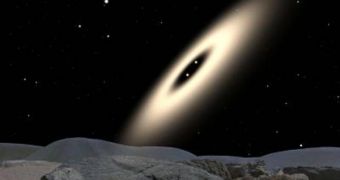For the first time, astronomers have identified a planetary disk rotating around a binary star system, which proves that massive planets, asteroid belts and Pluto-like objects can easily form around this type of systems, in very much the same way they do around single stars, such as our Sun. Discovered around the young binary star system V4046 Sagittarii, the disk was seen using the Harvard-Smithsonian Center for Astrophysics' Submillimeter Array (SMA).
“It's a case of seeing is believing. We had the first evidence for this rotating disk in radio telescope observations of V4046 Sagittarii that we made last summer. But at that point, all we had were molecular spectra, and there are different ways to interpret the spectra. Once we saw the image data from the SMA, there was no doubt that we have a rotating disk here,” Rochester Institute of Technology Astronomer Joel Kastner, who has also been the lead scientist on the new study, explains. The find was presented yesterday in a press conference at the 214th semi-annual meeting of the American Astronomical Society, held in Pasadena, California.
“We believe that V4046 Sagittarii provides one of the clearest examples yet discovered of a Keplerian, planet-forming disk orbiting a young star system. This particular system is made that much more remarkable by the fact that it consists of a pair of solar-mass stars that are approximately 12 million years old and are separated by a mere 5 solar diameters,” Harvard-Smithsonian Center for Astrophysics (CfA) expert David Wilner, one of the co-authors of the research, adds.
“This could be the oldest known orbiting protoplanetary molecular disk. It shows that, at least for some stars, formation of Jovian-mass planets may continue well after a few million years, which astronomers have deduced is characteristic of the formation time for most such planets,” University of California in Los Angeles (UCLA) Astronomer Ben Zuckerman, who has also been a contributor for the study, alongside Kastner, says.
“The most successful technique used so far for the discovery of extra-solar planets – that of measurement of precision radial velocities – is exceedingly difficult for close binary stars such as V4046 Sagittarii. So these radio observations are probing a new region of discovery space for extra-solar planets. At a distance of only 240 light-years from the solar system, the V4046 Sagittarii binary is at least two times closer to Earth than almost all known planet-forming star systems, which gives us a good shot at imaging any planets that have already formed and are now orbiting the stars,” UCLA graduate student David Rodriguez, who presented the finds at the conference, concludes.

 14 DAY TRIAL //
14 DAY TRIAL //